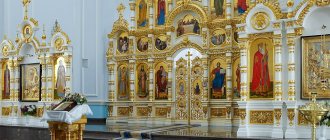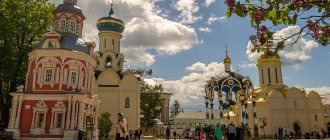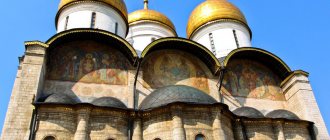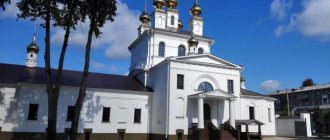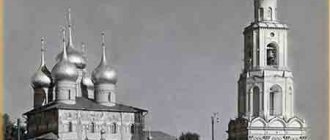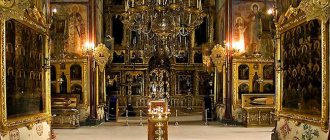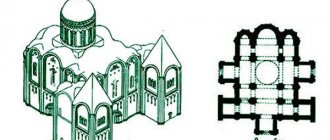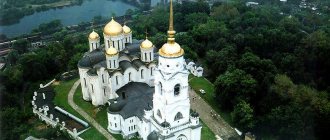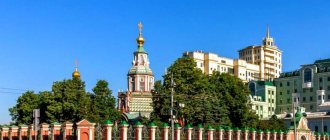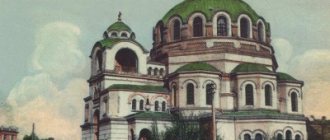Story
The Cathedral of the Assumption of the Blessed Virgin Mary was built and consecrated in 1873 . After which it had the status of a cathedral for 43 years and for part of this time it was the residence of the head of the Catholic Church in Russia . The Cathedral's parish grew very quickly, so it was enlarged and reconsecrated in 1897 .
Before the revolution, the Cathedral was regularly visited by about twenty thousand citizens. After 1917, the authorities made many attempts to stop the work of the Cathedral , which were successful by 1930 .
During the Second World War, the temple building was heavily damaged by bombs, and after that it was given over to the needs of the city . It was only in 1995 that the work of the Cathedral was restored, when its building was returned to the church .
The temple was restored and consecrated for the third time in 1998
Now there is a library and a museum in the Cathedral ; anyone can visit it , regardless of religion.
Assumption Church (Cathedral) in Vladimir
The first of the many Assumption churches in Rus' was erected in Kyiv in the 11th century. On the territory of modern Russia, the first Church of the Dormition of the Virgin Mary was founded by Prince Andrei Bogolyubsky in Vladimir in 1158. It was the main cathedral of Vladimir-Suzdal Rus' until the rise of Moscow in the 14th century. It was in it that the Vladimir and Moscow princes were married.
The cathedral was built in the Russian Romanesque architectural style. It is characterized by the use of smooth-hewn white stone and the use of sculptural decoration in the form of ornaments and humanoid fantastic creatures. The height of the structure is 32 meters. At the end of the 12th century, under Prince Vsevolod III, the temple was damaged by fire. During restoration, it was expanded and a gallery was added, which became a tomb for local princes and bishops. Its main builders, Andrei Bogolyubsky and Vsevolod III, were also buried within the walls of the cathedral. Considerable damage to the temple was caused during the Mongol-Tatar attacks on Vladimir (1238, 1411), which is why the structure was repaired several times.
At the beginning of the 15th century, the Vladimir Church was painted by outstanding ancient Russian icon painters Andrei Rublev and Daniil Cherny. Part of their fresco “The Last Judgment” has survived to this day. As for the original painting, only small fragments remain of it. The remaining surviving frescoes are relatively new and date back to the century before last.
The Church of the Assumption of the Virgin Mary was significantly renovated in the 18th and 19th centuries. Among other things, the ancient iconostasis was replaced and a four-level bell tower with a spire was added. Regular restorations of the cathedral began with the involvement of scientists. During Soviet times, the temple was turned into a museum. In 1944, at the request of believers, services were allowed to be held there.
Today, both divine services and museum excursions are held in the Vladimir Assumption Cathedral. This is a unique pre-Mongol architectural monument of federal significance, a UNESCO World Heritage Site. It served as a model for many later cathedrals, one of which (Moscow) became the main temple of united Rus'.
Architecture
The Cathedral of the Assumption of the Blessed Virgin Mary is shaped like a Latin cross . It has a common entrance with the Catholic Seminary, closed by its building from the street.
Located in a quiet, inconspicuous place, the Cathedral borders the Polish Garden, the former estate of the poet Derzhavin.
Interestingly, the land on which the temple stands was purchased from his heirs .
Interior decoration
The cathedral from the inside looks spacious and ascetic , with white walls and vaults, a mandatory attribute of the Catholic Church.
The room has excellent acoustics . There is a magnificent organ that often attracts parishioners and fans of incomparable organ music to concerts.
Exterior decoration
If from the street side the Cathedral building is inconspicuous, then from the Polish Garden the impressive apse opens up to the eye .
From this altar ledge one can immediately appreciate the majestic size of the temple building .
Assumption Church in Soviet times
The October Revolution destroyed the usual way of life of the monastery, its ministers and parishioners. 1919 marked the beginning of the eviction of clergy from the monastery.
In the 1920s, the authorities openly set out to close the Assumption Church at any cost. Mass arrests of brethren and parishioners began, which continued until 1932. The Assumption Church of the metochion was deprived of its high stauropegial status, but services continued here until the end of 1933.
In 1934, a decision was made to liquidate the temple and further organize a sports hall on its territory. The church doors were closed to parishioners for many years. Almost everything was taken out of it, from icons and iconostasis to chandeliers and other church utensils. Only the crosses continued to cover the orphaned church, until they were cut down just before the war. The revered icon of the Dormition of the Mother of God, the “image and measure” of the ancient Lavra image, was transferred from the ruined courtyard to the Prince Vladimir Cathedral.
At first, the church premises were converted into a warehouse for the Leningrad military port. The Metropolitan's chambers were divided, converted into a dormitory, and then into communal apartments. During the Great Patriotic War, the temple dome hid an air defense observation post, and a bomb shelter was installed in the church basement.
In 1956, construction of an ice skating rink with artificial turf began in the main church building. Already in 1961, most sports societies in Leningrad began training on its ice.
The existence of a skating rink in the church caused enormous damage to the building: the altar housed the engine room for refrigeration units and wardrobes, and buffets and storerooms for sports and technical equipment were organized in the choir. The entire central part of the former church was occupied by a vast ice field, and the auditorium was full of portraits of Lenin and other Soviet party leaders; Patriotic banners were displayed on the walls. All these “innovations” practically destroyed the expensive Metlakh tiles on the floors and paintings on the walls and ceiling.
The ice generated cold and dampness, from which the walls deteriorated, crumbled and were destroyed by fungus. Over time, maintaining a skating rink here simply became unprofitable. However, even after the closure of the ice arena, baths functioned for some time in the Assumption Church, and later plantations were set up to grow flowers for sale, which continued to maintain humidity in the building at unacceptable levels.
Schedule of services in 2022
On weekdays and Saturdays, Masses are held at 9 a.m. and 7 p.m.
Sunday Mass times:
- in Russian - 12 o'clock and 19 o'clock
- in Polish and French - 15 hours and 17 hours
There are also children's masses on Sunday at 10:30 am . The exception is during the summer holidays.
Restoration and revival
Only in 1991, with the blessing of His Holiness Patriarch Alexy II of Moscow and All Rus', the building of the Assumption Church was returned to the Russian Orthodox Church as a metochion of the Holy Vvedensky Stavropegic Monastery of Optina Pustyn.
Restoring the building required great expenses, technical and human resources, and enormous effort. Everyone who dreamed of seeing the Assumption Church again in its original form and in all its splendor took up the cause. Floors and wall paintings were restored, and mountains of construction waste were removed. In 1998, the main dome of the building acquired a cross, and in 2005 the dome was gilded. By 2003, the iconostasis was restored using archival photos. And only 10 years later the restoration of the wall paintings was completed.
On September 15, 2013, a great event took place - the ceremony of the great consecration of the restored Church of the Assumption of the Blessed Virgin Mary of the St. Petersburg metochion of Optina Hermitage on Vasilyevsky Island.
Today the entire complex of the farmstead is a cultural heritage site of federal significance.
Where is the Cathedral of the Assumption of the Blessed Virgin Mary located?
Address
st. 1st Krasnoarmeyskaya, building 11
Metro
Nearest station Technological Institute
How to get there
Take the metro to the Tekhnologichesky Institut-1 stop. Go to the side that is closer to the Fontanka. Walk 300 meters along 1st Krasnoarmeyskaya Street to the Seminary building, which will be on the right.
Telephone
8(812) 316-42-55; 989-49-39
Official site
uspenie.spb.ru/church
Cathedral of the Assumption of the Virgin Mary (Gurk)
- Address:
Dompl. 11, 9342 Gurk, Austria - Telephone:
+43 04266 823638 - Cost of visit:
from $11 - Opening hours:
daily 9:00 – 17:00
The Cathedral of the Assumption of the Virgin Mary in Gurka is the tallest Romanesque church in Austria. Pilgrims come here to venerate the relics of St. Emma, and history buffs come to admire the interesting interweaving of Gothic, Baroque and Rococo architectural styles. 90-minute tours of the entire building, including the crypt and treasury, are offered twice daily.
Story
In pre-Christian times, on the site of the cathedral there was a temple to the Celtic horse goddess Epona. The current building appeared in the 12th century. thanks to the donation of the famous aristocrat Emma Gurkska. This woman had a tragic fate, and in order to give her life some meaning, she began to spend her considerable fortune on building temples. In 1174, Emma was buried in the crypt of the Cathedral of the Assumption of the Virgin Mary in Gurka and canonized some time after her death. For centuries the temple stood as a mighty block, but the fire of 1808 seriously damaged it and completely destroyed the roof. Since then, the ancient church was consigned to oblivion, and only half a century later, the Prussian conservative Ferdinand von Quast rediscovered the cathedral and, with his publications, saved it from complete decline. Large-scale renovation work was carried out here, and today the building appears before us in all its grandeur.
Architecture
The first thing that guests who come to Gurk to look at the Cathedral of the Assumption of the Virgin Mary see are two mighty towers in the west of a stone block 60 m high. It is thanks to them that the temple became famous as the tallest among those built in the Romanesque style. The towers have narrow Romanesque arched windows at the bottom and large Baroque windows at the top floor. The onion domes have been preserved since 1678, and the tower clock appeared during restoration after the fire.
Temple inside
The external modesty of the cathedral contrasts sharply with its intricate interior decoration. The lacquered carved benches, colorful stained glass windows, arched arcades on the ceiling and the early Baroque high altar with 72 statues and 82 heads of angels make a stunning impression. The organ from 1781 is especially good, decorated with bronze vignettes and still delighting parishioners with its melodies during services.
Crypt
In order to get into the crypt of a hundred pillars, pilgrims from all over the world flock to the Cathedral of the Assumption of the Virgin Mary in Gurka. It measures 20 by 20 m and protrudes 1.75 m above the ground. It has 96 marble columns supporting the vault and decorated with figured ornaments. Here is also the tomb of St. Emma, crowned with a beautiful statue of her with a veiled face. The sarcophagus is surrounded by a forged lattice.
Treasury
Previously, this collection was called the Diocesan Museum, but then it was renamed the “Gurk Treasury”. There are no jewels here in the literal sense of the word, but it is a real treasure trove of riches in the history of religion and art. Visitors admire the extraordinary beauty of the 12th century stained glass window. with an image of Mary Magdalene, an ancient crucifix from 1170, a massive episcopal seal, the oldest surviving altar in Carinthia from the 15th century. and other religious rarities.
Church shop
The store at the Cathedral of the Assumption of the Virgin Mary in Gurka offers visitors to buy something to remember their visit to the church and thereby support the temple financially. This is not a gloomy room smelling of incense, but a bright arched space with convenient display cases. Here you can buy figurines of St. Emma, chic illustrated books on art, as well as the famous Gurkha balm infused with medicinal herbs.
How to get there?
The most convenient way to get to Gurk is from Graz by rail on the Rj.1 train. The travel time will be 2.5 hours, the fare is about $35. You need to get off at the station “Friesach In Kaernten”, and then take a taxi. In Gurka itself, it is not difficult to find the Cathedral of the Assumption of the Virgin Mary - this is the main attraction of the city.
